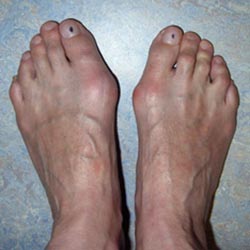 What is a bunion?
What is a bunion?
A bunion is specifically a prominent area of bone. Classically this is the term used to describe the region at the base of the big toe, which becomes prominent as the toe starts to point more towards the other toes. Medically this angulation of the big toe is termed hallux valgus.
Why do they develop?
Bunions themselves are thought to develop either because there is a genetic tendency (i.e. they tend to run in families) or because of shoewear (i.e. populations of people around the world who do not wear shoes have a lower incidence of bunions). A large number of people develop them by chance.
What symptoms do they cause?
The commonest problem is that the prominent area of bone may cause rubbing on shoes.
Bunions are thought to have some role in the development of hammer toes and other causes of pain in the so called “lesser toes”.
What options are there for treatment?
a. Wider fitting shoes
Those with a broad toe box (front of the shoe) will allow space for the toes. Soft pointed shoes conform to the angulation of the toe and may be comfortable.
b. Surgery
This is generally of three types:
1. Scarf osteotomy with or without an Akin osteotomy (See: Hallux Valgus Correction 1: Scarf )
The most commonly performed procedure.
2. Lapidus procedure with or without an Akin osteotomy (See: Hallux Valgus Correction 2: Lapidus)
In some cases where a more severe deformity is present.
3. Fusion of the 1st MTP (metatarsophalangeal joint) (See: Hallux Valgus Correction 3: Fusion)
When there is associated arthritis or a very severe deformity.
4. Minimally Invasive Chevron and Akin osteotomies (MICA)
In special circumstances this might be considered, but it requires an in depth discussion with your surgeon.
